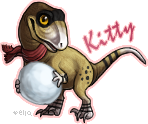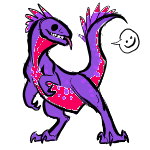how about Pterosaurs here some thing about tham Pterosaurs had large brains and fur-covered bodies. Some were the size of today's sparrows, while others were far larger. They had light, hollow bones, like those of birds. Although they had similarities to today's birds and bats, scientists do not believe that pterosaurs are the ancestors of either.Pterosaurs had hands. Three fingers were claws, but the long fourth finger was part of the wing. The wings had stiff fibres that were like the ribs of an umbrella, with thin leathery skin stretched over them. Scientists thought that pterosaurs were all gliders and did not flap their wings, but skeletons have been discovered with crests on the bones to which wing muscles would have been attached, which indicates they flew.
On land, pterosaurs probably crawled on all fours, like modern bats. They probably folded their wings back so that their fingers could grip the ground. Scientists are not sure how pterosaurs launched into flight. Some think they were so clumsy on land that they possibly jumped off cliffs or trees to get airborne. Others believe that they were able to land and take off in similar fashion to the birds of today.
Many pterosaur fossils and footprints have been found in areas next to seas or lakes, so they may have fed in a manner similar to today's water birds. Some had beaks similar to those of modern spoonbills or pelicans, or had strainer-like teeth to filter minute creatures from water. Some had long beaks which may have been used to plunge down into mud holes made by crustaceans.
Triassic Period
The earliest pterosaurs appeared during the Triassic period and were extinct by the end of the Jurassic period.They had long tails, short necks, and long, narrow wings. They were the first flying vertebrates (animals with spines).
They include:
Eudimorphodon:It had a wingspan of about 75 cm. It had large eyes, a short neck, many sharp teeth in pointed jaws. There was a diamond-shaped flap of skin at the end of a long, pointed tail. It lived in the Triassic.
Dimorphodon: It had a wingspan of just over 1 metre. It had deep, wide jaws rather like the beak of today's puffin. It lived in the early Jurassic period.
RhamphorhynchusIt had a wingspan about 1 m, and long, narrow jaws with sharp teeth pointing outwards. Its very long tail ended in a diamond-shaped flap. It lived in the late Jurassic.
Late in the Jurassic there appeared other pterosaurs with shorter tails. Most of them probably flapped their wings to fly. The larger ones, such as Pteranodon and Quetzalcoatlus, had wing spans so big that they probably glided on the air currents most of the time.
They include:
Pterodactylus: With a wingspan of 75 cm, it had long, narrow jaws with sharp teeth. It lived in the late Jurassic.
Pterodaustro: Its wingspan was just over 1 m. Its long, blunt jaws had long teeth in the lower jaw and tiny teeth in the upper jaw. It may have fed by skimming fish from the sea surface.
Pteranodon: It had a 7 m wingspan. It had a very long, bony head crest and a long beak with no teeth. It had no tail. It lived in the late Cretaceous period.
Quetzalcoatlus (kwet-zal-koh-at-lus)Named after the Aztec god Quezalcoatl, it lived in the Late Cretaceous. It was a huge pterosaur with a wingspan of up to 13 metres. It was the largest flying creature ever, and the last of the pterosaurs.
Even though it was huge, Quetzalcoatlus weighed only about 100 kg because its bones were light. It had a long neck and long toothless jaws. On top of its head there was a long bony crest. Paleontologists are unsure about how it lived. They know it was a carnivore, but some say it lived like a vulture does today, scavenging on the bodies of dead dinosaurs it found. Others believe that it used its long slender jaws to explore soft ground and shallow pools for crustaceans. Still others think it may have coasted slowly over the warm seas, scooping up surface fish.
Posted: 18/10/2010 @ 06:23 am





 Herbivores & Others - Accepted
Herbivores & Others - Accepted 







 ))
)) 



